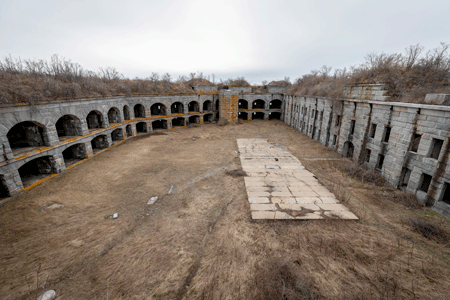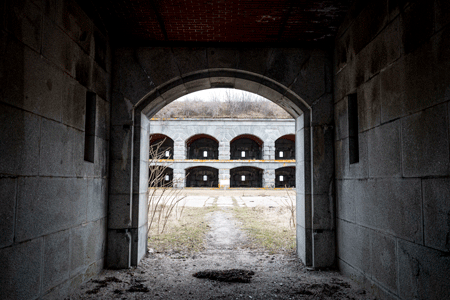PHOTOS BY JOEL PAGE
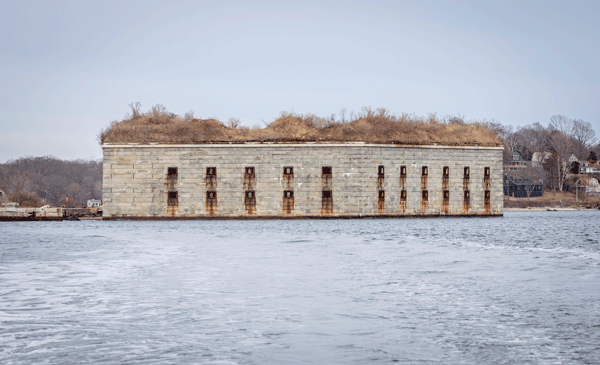
Fort Gorges has stood prominently in the middle of Portland Harbor for more than 150 years. A group that advocates on behalf of the granite Civil War-era fortress wants to make sure it stays that way into the future.
The Friends of Fort Gorges nonprofit organization is taking steps to raise additional funds toward improving the Portland-owned fort and making it more accessible to the public. Organization leaders are also asking out loud whether the fort would be better served under new ownership.

Paul Drinan, executive director of Friends of Fort Gorges, said it’s vital to stabilize and improve the historically significant fortress, which was modeled after Fort Sumter, the South Carolina fort where the Civil War began on April 12, 1861. While the Friends group has not made any formal proposal, Drinan said the time may have come for Fort Gorges to join the ranks of similar forts nationwide that are run as state or national parks.
“At the end of the day, there will never, ever be another Fort Gorges,” he said on a recent day while giving a tour of the fort. “Nobody will ever build anything like this ever again.”
The city of Portland now manages Fort Gorges as a city park and works in partnership with the Friends group to maintain and promote it. The city mows the fort’s parade grounds each year and contributed $16,000 toward an Army Corps of Engineers stabilization project six years ago.
But with the city’s Parks, Recreation and Facilities Department overseeing 67 parks, 30 playgrounds, 40 athletic fields, and 11 community gardens, it’s hard to put Fort Gorges high on the priority list, said Ethan Hipple, director of the department. If a new ownership opportunity presented itself, perhaps with the state or federal government, Hipple said he would be “all ears.”
“Ultimately we want what’s best for the fort,” he said. “If there’s another entity that has the resources to do more than the city of Portland can, I think it’s worth looking into.”
Named for Ferdinando Gorges, the proprietor of the Province of Maine from 1629-1647, Fort Gorges was one of 42 military forts built between 1816 and 1867 as part of a broad national defense strategy that included a new generation of waterfront defenses called the Third System of Coastal Fortifications. The stone and brick forts were built on the eastern seaboard, the Gulf of Mexico, and California and featured bombproof rooms, called casemates, and cannon openings, or embrasures.
Built between 1858 and 1865 on a barren rock called Hog Island, Fort Gorges was never in battle and troops were never stationed there. The navy used it to store mines and munitions during World War I, and mines, munitions, and anti-submarine equipment during World War II. The federal government gave it to Portland in 1960.
A 2016 study estimated that 8,000 people visit the fort each year, but Drinan thinks the number has since grown to 10,000 or more. Most visitors arrive by kayak, and those who go by power boat have to arrive and depart within two hours of high tide. In recent years, the Friends has organized musical and theater performances and other events to small groups of fewer than 50 people, transporting them on a private charter boat. The Friends, along with a number of boat owners and tour companies, also offer historical tours.
Fort Gorges has undergone periodic improvements, such as the Army Corps project for stabilization and safety improvements that included steel railings and an observation outlook offering a spectacular view of the city and the surrounding islands. But overall, a lack of maintenance and the forces of nature have their toll on the structure.
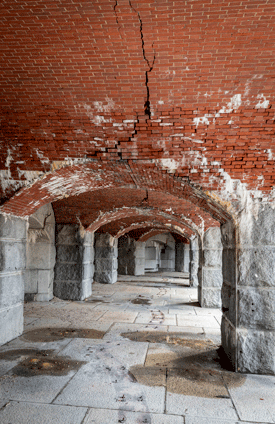
Take a walk through the fort and you’ll see brick-masonry arches that are separating, bricks that have fallen free, and a walkway that is slowly sinking. The fort’s granite block wharf is in need of repair, and viewing areas on top of the fort are overgrown and unsafe. A sign at the entrance warns visitors to “Enter at Your Own Risk.”
The Friends group is now taking steps to tap into additional funding that, in time, could be used to stabilize the fort and increase access for visitors. It plans to petition the National Register of Historic Places to have its “level of significance” elevated on the register from local to national—thereby opening up new opportunities for grant funding. It has also submitted applications with the offices of Sen. Susan Collins and Rep. Chellie Pingree for $1.1 million in earmarks, to be voted on by Congress this fall, to rebuild the massive granite wharf. If that happens, Drinan said, the group could install a dock with a gangway that would allow more boats to visit.
The Friends group also thinks it’s worth considering what the best ownership structure might be. Drinan likes the idea of turning it into a state park, but is also open to it becoming part of the National Park System or perhaps taken over by a land trust that has more resources than the city.
Of the 42 Third System forts built after the War of 1812, one is gone and a couple are in ruins, said John Weaver, a fort historian and author of A Legacy in Brick and Stone: American Coastal Defense Forts of the Third System, 1816-1867.
Of those still standing, about half are owned by the federal government and about a third by state governments, he said. A handful are privately owned, and three—including Fort Gorges—are owned by the cities in which they’re located.
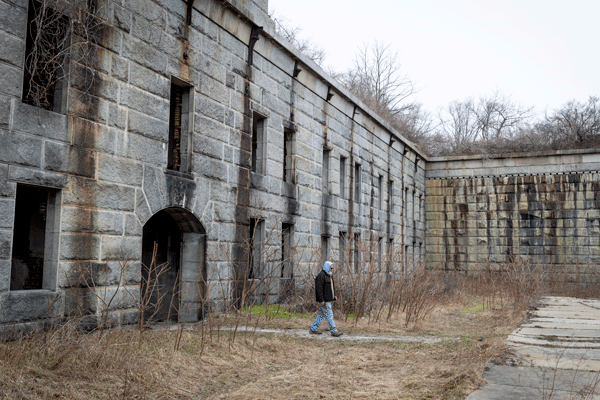
Weaver has spent more than 40 years studying these forts, and has visited all of them multiple times. While each fort is different, Weaver thinks the federal government is probably the best owner for them. “The National Park System does an incredibly good job and has adequate funding to take care of these forts,” he said.
Steve Russell, a Friends of Fort Gorges board member, said one model worth looking at is Fort Knox, a Third System fort on the banks of the Penobscot River in Prospect. Fort Knox is owned by the state and leased to and managed by the Friends of Fort Knox organization.
“It’s a matter of figuring out the pieces of the puzzle and making them fit,” Russell said while joining Drinan on the visit to the fort.
Bureau of Parks and Lands spokesman Jim Britt said both he and Bureau Director Andy Cutko have visited Fort Gorges and agree that it’s special and unique. But they also recognize that it would be “massive project” to make it a state park and transform it into what the Friends of Fort Gorges imagine it could be.
Maine’s state parks, which attract more than 3 million visitors annually, are now undergoing numerus maintenance and improvement projects using $50 million in federal relief funds allocated to Maine under the American Rescue Plan Act, Britt said.
“The appeal of the fort is great, and it absolutely is a great idea,” Britt said. “But now is not the time for the Bureau of Parks and Lands to consider a project of that magnitude for a number of reasons, including limited funding, limited staffing, and the monumental task facing the bureau right now of the state park restorations that are getting underway. So now would not be the time.”
